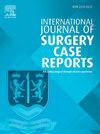Primary hydatid cyst in the axillary region: A case report
IF 0.6
Q4 SURGERY
引用次数: 0
Abstract
Introduction
Hydatid disease, caused by the larval stage of Echinococcus granulosus, is a significant zoonotic infection predominantly affecting the liver and lungs. While hydatid cysts are commonly found in internal organs, cases in the axillary region are rare.
Presentation of case
We report a unique case of a 52-year-old female patient presenting with a painless left axillary swelling for two years. Physical examination revealed a firm, mobile mass measuring 10 × 5 cm, with no associated lymphadenopathy. Laboratory tests indicated normal results, while ultrasound imaging confirmed a thick-walled cystic lesion. The patient underwent total cystectomy under general anesthesia, and histopathological analysis confirmed the diagnosis of a hydatid cyst.
Discussion
Hydatid cysts typically originate in the liver or lungs, with axillary primary cysts being rarely documented, with less than 20 prior cases in English literature. The mechanism for larvae migration to the axillary region remains unclear. The patient exhibited a mobile, asymptomatic mass, and imaging studies were crucial for diagnosis, emphasizing that differential diagnoses should include various axillary masses such as lymphadenitis or neoplasms.
Conclusion
This case highlights the need for awareness of axillary hydatid cysts in endemic regions, which may be misdiagnosed due to their rarity. Prompt diagnosis and individualized treatment, including total cystectomy and adjunctive medical therapy with albendazole, are critical to prevent complications and recurrence of hydatid disease.
求助全文
约1分钟内获得全文
求助全文
来源期刊
CiteScore
1.10
自引率
0.00%
发文量
1116
审稿时长
46 days

 求助内容:
求助内容: 应助结果提醒方式:
应助结果提醒方式:


